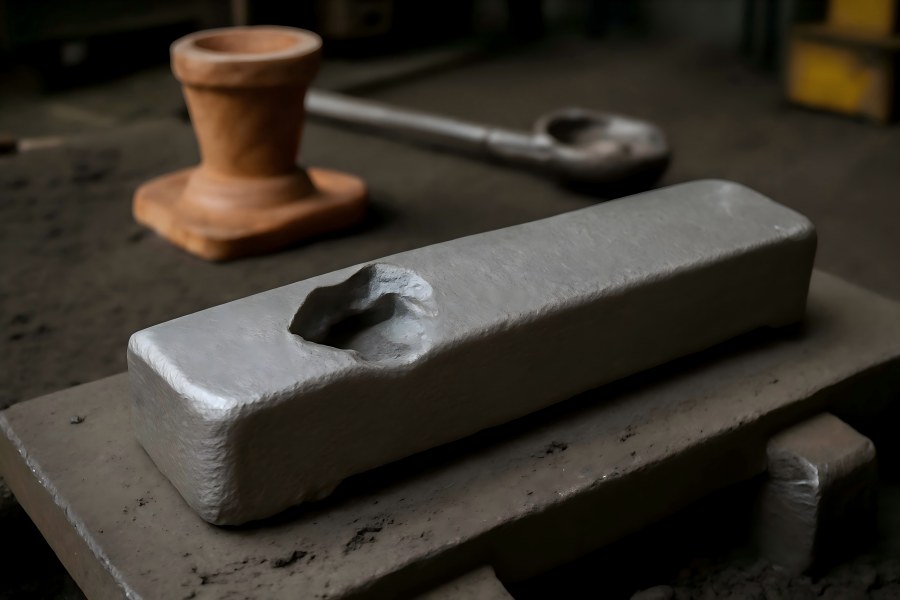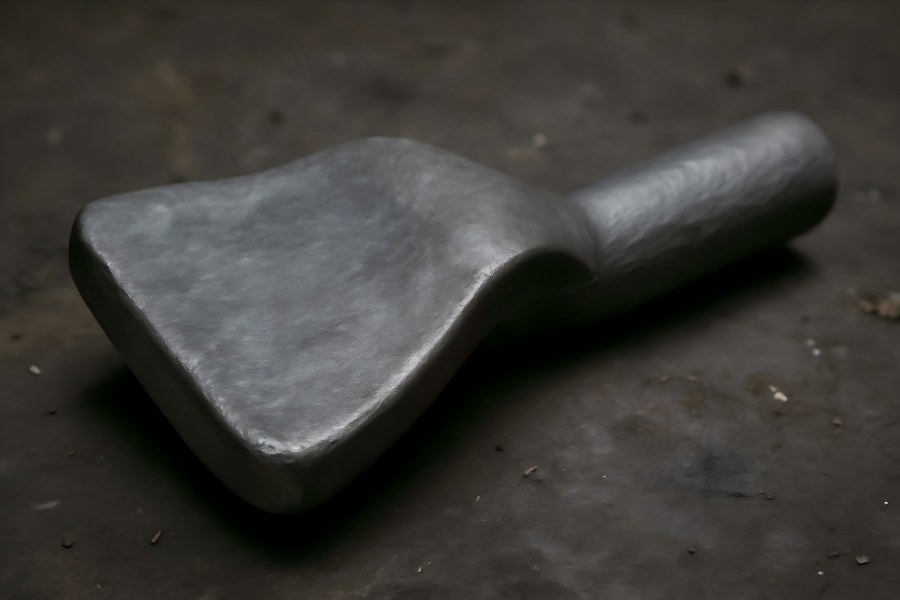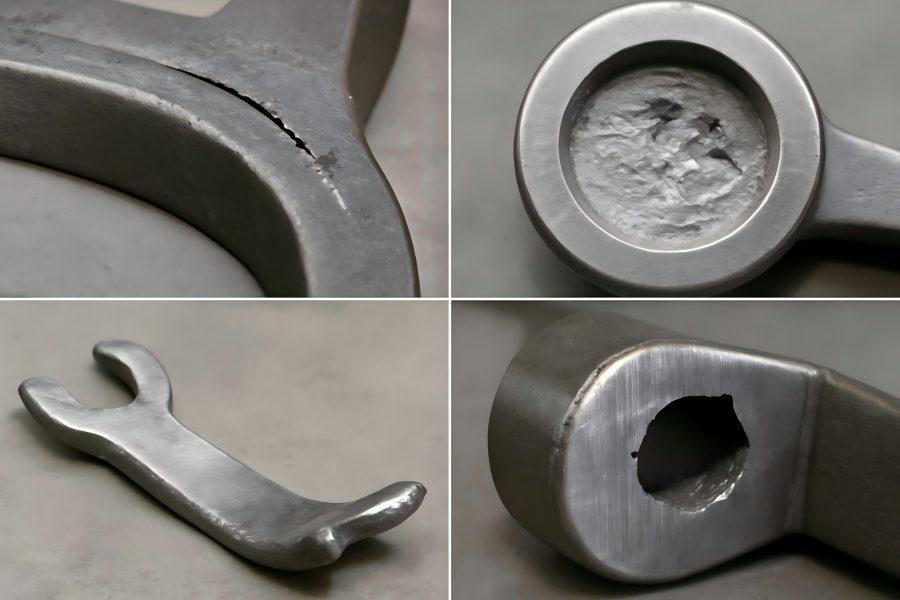Forging shapes metals like steel, aluminum, and titanium into strong, durable parts using compressive forces. However, defects arising from temperature, pressure, material properties, or mold design can affect quality, increase rework, and raise costs. Improving product performance, cutting waste, and increasing efficiency all depend on fixing these flaws.
This article covers nine common forging defects, their causes, solutions, and commercial benefits, helping manufacturers reduce rework and improve quality.
1. Cold Shut
When two streams of molten metal collide but are unable to fuse correctly, a cold shut happens, leaving a weak plane or visible seam in the forged portion. This flaw may weaken the component’s structural integrity and cause weak spots that could break under pressure.
Causes:
- Inadequate metal fluidity: When the pouring temperature is too low, the molten metal may solidify before it can properly fuse with another metal stream.
- Slow or interrupted pouring: If the pouring process is interrupted or too slow, the molten metal may solidify prematurely, creating cold shut regions where two streams of metal meet but do not properly bond.
- Poor gating system design: An inefficient gating system can lead to turbulence or excessive oxide film formation, which prevents proper fusion of the molten metal.
Solutions:
- Adjust pouring temperature: Ensuring that the molten metal is at the right temperature ensures better fluidity, allowing for smooth fusion at the point where the streams meet.
- Optimize gating design: The gating system must be designed to allow for smooth and continuous flow of the molten metal without excessive turbulence. This also minimizes oxide film formation and ensures proper fusion.
- Use of fluxing and degassing techniques: By minimizing the presence of oxides in the molten metal, manufacturers can avoid the formation of weak spots or seams.
Commercial Benefit:
Addressing cold shut defects leads to stronger parts with enhanced structural integrity. This reduces the need for rework, increases first-pass yield, and ensures the production of high-quality, durable components. Reducing defects also boosts customer satisfaction and reduces production costs.
2. Misrun (Incomplete Filling)
A misrun defect occurs when the molten metal fails to completely fill the mold before it solidifies. This results in incomplete parts or areas where the metal has not fully flowed into the mold cavity, leading to weak or unusable components.
Causes:
- Low pouring temperature: The molten metal hardens before filling the mold cavity entirely when the pouring temperature is too low.
- Inadequate gating system design: Inadequate gating system design can impede the flow of molten metal, resulting in partial mold filling.
- Cold molds or cores: If the mold or core is too cold, the molten metal may solidify prematurely before it reaches the farthest sections of the mold.
Solutions:
- Increase pouring temperature: Raising the pouring temperature improves fluidity, allowing the molten metal to flow smoothly into all areas of the mold before it solidifies.
- Re-design gating system: Ensure that the gating system is properly sized and positioned to allow for efficient flow of the molten metal into all sections of the mold.
- Preheat molds and cores: Preheating molds and cores helps maintain the fluidity of the molten metal and prevents premature solidification.
Commercial Benefit:
Addressing misruns ensures complete filling of the mold, leading to parts that meet dimensional and strength requirements. This reduces scrap, minimizes the need for rework, and optimizes production efficiency.
3. Shrinkage Cavities

As metal cools and hardens, voids known as shrinkage cavities develop inside the metal. These cavities can create weak spots in the forged part and may reduce its overall strength, leading to potential failure under stress or fatigue.
Causes:
- Insufficient feeding of molten metal: The metal compresses as it cools. Shrinkage cavities will develop if the gating system or mold does not provide enough molten metal to offset this contraction.
- Non-uniform section thickness: Parts with areas of varying thickness will cool at different rates, leading to the formation of shrinkage cavities in the thickest sections.
- Low pouring temperature: If the pouring temperature is too low, it can cause early skin solidification, which leads to trapped voids within the metal.
Solutions:
- Optimize riser and gating design: Ensure that the riser and gating system can provide sufficient molten metal to the last solidifying areas of the mold.
- Use chills or insulation: Adding chills or insulation to areas prone to shrinkage helps to control cooling rates and promotes directional solidification towards the feeder.
- Ensure uniform section thickness: Design parts with uniform thickness to ensure that all areas solidify at a similar rate, reducing the likelihood of shrinkage.
Commercial Benefit:
By eliminating shrinkage cavities, manufacturers can produce stronger, more reliable parts. This minimizes the risk of failures in service and reduces the need for repairs or warranty claims, ultimately leading to higher profitability.
4. Hot Tears / Hot Cracks
Hot tears or cracks occur when internal stresses generated during solidification exceed the material’s tensile strength, causing fractures in the forged part. These cracks typically form in areas with sharp geometry, thin sections, or high-stress concentrations.
Causes:
- Stress concentrations: Abrupt changes in section thickness or sharp corners can create areas of high internal stress during solidification, leading to cracks.
- Mold material restrictions: Mold materials that do not allow for sufficient movement during solidification can create unnecessary restraint, increasing the risk of hot tears.
- Thermal gradients: Rapid cooling or large temperature differences between the mold and metal can lead to uneven contraction, generating stress and causing cracking.
Solutions:
- Gradual section transitions: Use fillets instead of sharp corners and ensure gradual transitions in section thickness to reduce stress concentrations.
- Flexible mold materials: Use mold materials that allow for some movement during solidification, which reduces mechanical restraint and lowers the risk of cracking.
- Controlled cooling rates: Use chills, insulation, or cooling systems to moderate the cooling rate and reduce thermal gradients, which can help control shrinkage stresses.
Commercial Benefit:
By minimizing hot tears or cracks, manufacturers can produce parts that are structurally sound and less prone to failures. As a result, the product quality is improved overall and there are less flaws and scrap.
5. Inclusions (Non-Metallic)
Inclusions are foreign materials, such as oxide films, slag, or sand, that are trapped within the forged part. These contaminants can significantly reduce the mechanical properties of the part, including its fatigue strength and surface finish.
Causes:
- Poor filtration of molten metal: If the molten metal is not properly filtered before it enters the mold, it can carry contaminants such as slag or oxide particles.
- Turbulence during pouring: High pouring speeds or turbulent metal flow can cause oxide films or slag to become entrained in the molten metal, leading to inclusion defects.
- Degraded furnace or ladle linings: Contaminated furnace or ladle linings can introduce foreign particles into the molten metal, leading to inclusions.
Solutions:
- Proper filtration systems: Use ceramic foam filters or mesh filters to remove impurities from the molten metal before pouring.
- Control pouring speed: Reduce turbulence during pouring to minimize the risk of entraining oxides or slag into the molten metal.
- Maintain furnace and ladle quality: Regularly inspect and clean furnace and ladle linings to prevent contamination of the molten metal.
Commercial Benefit:
Reducing inclusions improves the mechanical properties and surface finish of the forged parts, leading to fewer machining issues, better customer satisfaction, and reduced rework costs.
6. Warpage and Distortion

Warpage refers to the bending, twisting, or distortion of a forged part during or after solidification. This defect can lead to parts that do not meet dimensional specifications, requiring additional rework or adjustments.
Causes:
- Uneven cooling: Differences in section thickness can lead to uneven cooling rates, causing parts to warp or distort.
- Inadequate support during cooling: If the part is not adequately supported during cooling, it may deform under its own weight or due to thermal stresses.
- Mold design restrictions: Rigid molds that do not allow for controlled contraction can lead to deformation during the solidification process.
Solutions:
- Uniform section thickness: Design parts with uniform thickness to ensure that all areas cool and solidify at a similar rate, reducing the risk of warpage.
- Adequate fixturing and support: Provide adequate support during solidification and cooling to prevent distortion or sagging.
- Use of chills and controlled cooling systems: These can help regulate the cooling process and reduce thermal gradients, minimizing distortion.
Commercial Benefit:
By minimizing warpage, manufacturers can produce parts that meet dimensional tolerances, reducing the need for re-machining and improving production efficiency. This ultimately reduces rework costs and improves customer satisfaction.
7. Gas Defects (Blowholes, Pinholes)
Gas defects, such as blowholes and pinholes, occur when gases become trapped in the molten metal during solidification. The part’s structural integrity and surface finish may be jeopardized by these flaws.
Causes:
- Moisture or volatiles in the mold: When moisture or volatile materials in the mold come into contact with molten metal, they generate gas that can become trapped within the casting.
- Poor venting: Inadequate venting during the pouring process can lead to trapped gas, causing voids such as blowholes or pinholes.
- High dissolved gas content in the molten metal: High levels of dissolved gases in the molten metal, such as hydrogen in aluminum, can release during cooling and form cavities.
Solutions:
- Dry molds and cores: Ensure that molds and cores are thoroughly dried before use to prevent gas generation during pouring.
- Improve venting: Provide dedicated vent channels, bleed holes, or use high-permeability materials to allow gas to escape before the metal solidifies.
- Degas the molten metal: Use degassing techniques to reduce the dissolved gas content in the molten metal, reducing the likelihood of gas defects.
Commercial Benefit:
By addressing gas defects, manufacturers can improve the surface finish and functionality of their parts, leading to fewer failures in service and better customer satisfaction.
8. Cold Shut (Improper Fusion of Metal Fronts)
When two fronts of molten metal collide but do not fuse correctly, a weak seam is left behind that may cause structural failure under stress. This phenomenon is known as cold shut.
Causes:
- Inadequate pouring temperature and fluidity: If the molten metal is not hot enough, it may solidify too quickly before proper fusion occurs.
- Slow or interrupted pouring: If pouring is slow or interrupted, metal may solidify before the second stream of molten metal reaches it.
- Poor gating and runner design: An inefficient gating system can cause metal to lose momentum or become contaminated with oxides.
Solutions:
- Increase pouring temperature: A higher pouring temperature ensures better metal fluidity and promotes better fusion at the point where the metal streams meet.
- Optimize gating design: Improve the gating system to ensure smooth and continuous flow of metal, without excessive turbulence.
- Minimize oxide formation: Use proper fluxing and degassing techniques to maintain clean molten metal and avoid the formation of weak seams.
Commercial Benefit:
By preventing cold shuts, manufacturers can ensure the production of structurally sound parts with fewer defects, improving first-pass yields and reducing scrap.
9. Mold/Core Shift
Mold or core shift refers to misalignment between the mold halves or movement of the cores during pouring, leading to dimensional inaccuracies and poor part fit.
Causes:
- Poor alignment or inadequate securing of mold halves: Misalignment during pouring can result in dimensional inaccuracies and irregular part geometry.
- Vibration or hydraulic pressure during pouring: These forces can cause the mold to shift or the cores to move out of place.
- Insufficient core support: If cores are not properly supported, they may shift or become displaced during the pouring process.
Solutions:
- Precise alignment systems: Use robust alignment systems to ensure the mold halves are properly aligned before pouring.
- Secure molds and cores: Secure the molds and cores properly to minimize movement during the pouring process.
- Support for cores: Use chaplets or other forms of support to keep cores in place during the pouring and solidification processes.
Commercial Benefit:
Reducing mold/core shift improves dimensional accuracy and ensures the production of high-quality, precisely shaped parts. This minimizes rework and reduces production costs.
Conclusion
In order to streamline production processes, minimize scrap, and improve product quality, producers must address typical forging problems and put effective solutions in place. By focusing on proper design, material handling, and process optimization, manufacturers can achieve higher yields, improve part reliability, and reduce the need for costly rework.
